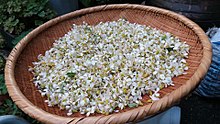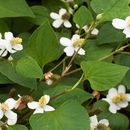Comments
provided by eFloras
Leaves used medicinally; shoots eaten as a vegetable.
- license
- cc-by-nc-sa-3.0
- copyright
- Missouri Botanical Garden, 4344 Shaw Boulevard, St. Louis, MO, 63110 USA
Description
provided by eFloras
Herbs (5-)30-60 cm high; rhizomes creeping, thin. Basal part of stems creeping, rooted in whorls at nodes, apical part erect, glabrous or pubescent on nodes, sometimes purplish red.
Stipular sheath (0.5-)1-2.5 cm, 1/4-1/2 as long as petiole, usually ciliate, base enlarged and slightly clasping; petiole (0.7-) 1-3.5(-4) cm, glabrous; leaf blade broadly ovate or
ovate-cordate, (1.5-)4-10 × (1.8-)2.5-6 cm, thinly papery, densely glandular, usually glabrous, sometimes pubescent at vein axils, usually purplish abaxially, base cordate, apex shortly
acumi
nate; veins 5-7, basal or innermost pair arising ca. 5 mm above base, if 7-veined, then outermost pair very slender or inconspicuous; reticulate veins ± conspicuous. Inflorescences (0.4-)
1.5-2.5(-2.7) cm × (2-)5-6 mm; peduncles 1.5-3 cm, subglabrous; involucral bracts oblong or obovate, (5-)10-15 × (3-)5-7 mm, apex rounded. Bract beneath each flower linear, terete,
inconspicuous. Stamens longer than ovary. Capsule 2-3 mm, with persistent styles. Fl. Apr-Sep, fr. Jun-Oct. 2n = 24*, 96.
- license
- cc-by-nc-sa-3.0
- copyright
- Missouri Botanical Garden, 4344 Shaw Boulevard, St. Louis, MO, 63110 USA
Distribution
provided by eFloras
Himalaya (Punjab to NEFA), S. Tibet, Assam, Thailand, east to China and Japan.
- license
- cc-by-nc-sa-3.0
- copyright
- Missouri Botanical Garden, 4344 Shaw Boulevard, St. Louis, MO, 63110 USA
Distribution
provided by eFloras
Anhui, Fujian, Gansu, Guangdong, Guangxi, Guizhou, Hainan, Henan, Hubei, Hunan, Jiangxi, Shaanxi, Sichuan, Taiwan, Xizang, Yunnan, Zhejiang [Bhutan, India, Indonesia (?Java), Japan (including Ryukyu Islands), Korea, Myanmar, Nepal, Sikkim, Thailand].
- license
- cc-by-nc-sa-3.0
- copyright
- Missouri Botanical Garden, 4344 Shaw Boulevard, St. Louis, MO, 63110 USA
Elevation Range
provided by eFloras
1300-2500 m
- license
- cc-by-nc-sa-3.0
- copyright
- Missouri Botanical Garden, 4344 Shaw Boulevard, St. Louis, MO, 63110 USA
Habitat
provided by eFloras
Ravines, streamsides, forests, wet meadows, slopes, thicket and field margins, trailsides, roadsides, ditch banks; near sea level to 2500 m.
- license
- cc-by-nc-sa-3.0
- copyright
- Missouri Botanical Garden, 4344 Shaw Boulevard, St. Louis, MO, 63110 USA
Synonym
provided by eFloras
Polypara cochinchinensis Loureiro; P. cordata Kuntze.
- license
- cc-by-nc-sa-3.0
- copyright
- Missouri Botanical Garden, 4344 Shaw Boulevard, St. Louis, MO, 63110 USA
Cyclicity
provided by Plants of Tibet
Flowering from April to September; fruiting from June to October.
Distribution
provided by Plants of Tibet
Houttuynia cordata is occurring in Anhui, Fujian, Gansu, Guangdong, Guangxi, Guizhou, Hainan, Henan, Hubei, Hunan, Jiangxi, Shaanxi, Sichuan, Taiwan, Xizang, Yunnan, Zhejiang of China, Bhutan, India, Indonesia, Japan (including Ryukyu Islands), Korea, Myanmar, Nepal, Sikkim, Thailand.
Evolution
provided by Plants of Tibet
Phylogeny of Saururaceae was inferred from matR gene (Meng et al., 2002). The result indicates that Saururaceae is monophyletic. Anemopsis is sister to Houttuynia, and the two genera form the first diverging lineage of the family. The result is different from all the former phylogenetic opinions on Saururaceae based on morphology, but it is supported by the evolution of flower-bract stalk in Saururaceae.
General Description
provided by Plants of Tibet
Herbs (5-) 30-60 cm high; rhizomes creeping, thin. Basal part of stems creeping, rooted in whorls at nodes, apical part erect, glabrous or pubescent on nodes, sometimes purplish red. Stipular sheath 1-2.5 cm, 1/4-1/2 as long as petiole, usually ciliate, base enlarged and slightly clasping; petiole 1-3.5 cm, glabrous; leaf blade broadly ovate or ovate-cordate, 4-10 cm long, 2.5-6 cm wide, thinly papery, densely glandular, usually glabrous, sometimes pubescent at vein axils, usually purplish abaxially, base cordate, apex shortly acuminate; veins 5-7, basal or innermost pair arising ca. 5 mm above base, if 7-veined, then outermost pair very slender or inconspicuous; reticulate veins ± conspicuous. Inflorescences 1.5-2.5 cm long, 3-6 mm wide; peduncles 1.5-3 cm, subglabrous; involucral bracts oblong or obovate, 10-15 mm long, 5-7 mm wide, apex rounded. Bract beneath each flower linear, terete, inconspicuous. Stamens longer than ovary. Capsule 2-3 mm, with persistent styles.
Genetics
provided by Plants of Tibet
The chromosomal number of Houttuynia cordata is 2n = 96 (Okada, 1986).
Habitat
provided by Plants of Tibet
Growing in ravines, streamsides, forests, wet meadows, slopes, thicket and field margins, trailsides, roadsides, ditch banks; near sea level to 2500 m.
Uses
provided by Plants of Tibet
The leaves of Houttuynia cordata is used medicinally, shoots eaten as a vegetable.
Houttuynia cordata
provided by wikipedia EN
Houttuynia cordata, also known as fish mint, fish leaf, rainbow plant, chameleon plant, heart leaf, fish wort, or Chinese lizard tail, is one of two species in the genus Houttuynia (the other being H. emeiensis). It is a flowering plant native to Southeast Asia.[1] It grows in moist, shady locations.[2] It was named after Martinus Houttuyn.
Growth
Houttuynia cordata is a herbaceous perennial plant that can grow to 0.6–1 m (2 ft 0 in – 3 ft 3 in), spreading up to 1 m (3 ft 3 in).[2][1] The proximal part of the stem is trailing and produces adventitious roots, while the distal part of the stem grows vertically. The leaves are alternate, broadly heart-shaped, 4–9 cm (1+1⁄2–3+1⁄2 in) long and 3–8 cm (1–3 in) broad. Its flowers are greenish-yellow and borne on a terminal spike 2–3 cm (3⁄4–1+1⁄4 in) long with four to six large white basal bracts.[2][1] It normally blooms in the summer.
It is considered an invasive plant because of its ability to regrow rhizomes from any segment of its foliage.[3]
Cultivation

Houttuynia cordata 'Chameleon'
Houttuynia cordata grows in moist to wet soil or slightly submerged in water, as long as it is exposed partially or fully to the sun.[2][1] It can become invasive in gardens and difficult to eradicate as their roots run deep and actively spread. It propagates by division.
It is usually found in one of its cultivated forms in temperate gardens. The 'Chameleon' variety (synonymous with H.cordata 'Court Jester', 'Tricolour', and 'Variegata') is slightly less vigorous than the parent species, with stubbier leaves mottled in both yellow and red. Another common variety, 'Flore Pleno', has masses of white bracts and retains the vigor of the parent species.
Houttuynia cordata has been naturalized in North America.[4]
Usage
Culinary use

Flowers picked for
yakmomil-kkot-cha (flower tea) in
sokuri
It is commonly grown as a leaf vegetable, and is used as a fresh herbal garnish.[2] The leaf has an unusual taste from its volatile oil decanoyl acetaldehyde (Houttuynine), a taste that is often described as "fishy", earning it the nickname "fish mint".
In northeastern India, the leaves are commonly used in salads, salsas, or cooked with other vegetables, and as a garnish over side dishes. The tender roots can also be ground into chutneys along with dry meat or fish, chilies, and tamarind. It is taken raw as salad and cooked along with fish as fish curry. In Japan and Korea, the dried leaves may be used as an herbal tea, which is believed to have healing properties. It is called dokudami-cha (どくだみ茶) in Japan and eoseongcho cha (어성초차) in Korea.
In Vietnamese cuisine, the plant is called diếp cá and is used with grilled meat and noodle salad dishes.[5] Fish mint may be used as a garnish with several Vietnamese dishes, such as gỏi cuốn, stir-fried beef with fish mint salad,[6][7] and bánh xèo.[8]

Zhe'ergen is often served as a cold salad after being washed, chopped and tossed with sauces derived from vinegar, chilli, coriander and soy sauce.
Zhé'ěrgēn (Chinese: 折耳根, "broken ear-root") is the edible rhizome of Houttuynia cordata (yúxīngcǎo; 魚腥草; "fish-smelling grass") with a fresh, spicy, peppery flavour that is used in southwestern Chinese cuisine, i.e. that of Guizhou, Sichuan, Yunnan and western Guangxi. Typically the leaves are eaten in Sichuan and the root in Guizhou. Zhé'ěrgēn fried with larou (cured pork belly) is one of the staple dishes of Guizhou.
Notable uses include:
The leaves are also a little peppery and are frequently consumed in the region.
Traditional medicine
Houttuynia cordata was used in traditional Chinese medicine, including by Chinese scientists in an attempt to treat SARS[9] and various other disorders,[10] although there is no high-quality clinical research to confirm such uses are safe or effective, as of 2018. When administered via injection, H. cordata can cause severe allergic reactions.[11]
Aroma profile
Chemical compounds that contribute to the aroma of H. cordata include β-myrcene[12][13] and 2-undecanone.[14]
See also
References
-
^ a b c d "Houttuynia cordata, Thunb". KewScience, The Royal Horticultural Society, UK. 2018. Retrieved 8 October 2018.
-
^ a b c d e "Houttuynia cordata Thunb". Plants for a Future. 2012. Retrieved 9 April 2018.
-
^ "Houttuynia cordata (Chameleon Plant, Rainbow Plant) | North Carolina Extension Gardener Plant Toolbox". plants.ces.ncsu.edu. Retrieved 29 September 2020.
-
^ Global Invasive Species Database: Houttuynia cordata, accessed 2008-07-06
-
^ Vietnamese Herbs: Fish Mint, Accessed 9 October 2018.
-
^ Sunset: 5 Delicious Vietnamese Herbs to Grow and Eat, Accessed 9 October 2018.
-
^ Cookpad, CookBook Inc., Accessed 9 October 2018
-
^ NPR Inc.:Banh Xeo (Sizzling Crepes), Accessed 10 October 2018
-
^ Lau, K. M; Lee, K. M; Koon, C. M; Cheung, C. S; Lau, C. P; Ho, H. M; Lee, M. Y; Au, S. W; Cheng, C. H; Lau, C. B; Tsui, S. K; Wan, D. C; Waye, M. M; Wong, K. B; Wong, C. K; Lam, C. W; Leung, P. C; Fung, K. P (2008). "Immunomodulatory and anti-SARS activities of Houttuynia cordata". Journal of Ethnopharmacology. 118 (1): 79–85. doi:10.1016/j.jep.2008.03.018. PMC 7126383. PMID 18479853.
-
^ Kumar, M; Prasad, S. K; Hemalatha, S (2014). "A current update on the phytopharmacological aspects of Houttuynia cordata Thunb". Pharmacognosy Reviews. 8 (15): 22–35. doi:10.4103/0973-7847.125525. PMC 3931198. PMID 24600193.
-
^ Wang, L; Cui, X; Cheng, L; Yuan, Q; Li, T; Li, Y; Deng, S; Shang, H; Bian, Z (2010). "Adverse events to Houttuynia injection: A systematic review". Journal of Evidence-Based Medicine. 3 (3): 168–76. doi:10.1111/j.1756-5391.2010.01091.x. PMID 21349062. S2CID 25810338.
-
^ Lu, Hongmei; Wu, Xianjin; Liang, Yizeng; Zhang, Jian; et al. (2006). "Variation in Chemical Composition and Antibacterial Activities of Essential Oils from Two Species of Houttuynia Thunb". Chemical & Pharmaceutical Bulletin. 54 (7): 936–940. doi:10.1248/cpb.54.936. PMID 16819207.
-
^ Ch, Muhammad Ishtiaq; Wen, YF; Cheng, Y; et al. (2007). "Gas Chromatographic/Mass Spectrometric Analysis of the Essential Oil of Houttuynia cordata Thunb by Using On-Column Methylation with Tetramethylammonium Acetate". Journal of AOAC International. 90 (1): 60–67. doi:10.1093/jaoac/90.1.60. PMID 17373437.
-
^ Liang, Minmin; Qi, M; Zhang, C; Zhou, S; Fu, R; Huang, J; et al. (2005). "Gas chromatography–mass spectrometry analysis of volatile compounds from Houttuynia cordata Thunb after extraction by solid-phase microextraction, flash evaporation and steam distillation". Analytica Chimica Acta. 531 (1): 97–104. doi:10.1016/j.aca.2004.09.082.

- license
- cc-by-sa-3.0
- copyright
- Wikipedia authors and editors
Houttuynia cordata: Brief Summary
provided by wikipedia EN
Houttuynia cordata, also known as fish mint, fish leaf, rainbow plant, chameleon plant, heart leaf, fish wort, or Chinese lizard tail, is one of two species in the genus Houttuynia (the other being H. emeiensis). It is a flowering plant native to Southeast Asia. It grows in moist, shady locations. It was named after Martinus Houttuyn.
- license
- cc-by-sa-3.0
- copyright
- Wikipedia authors and editors


